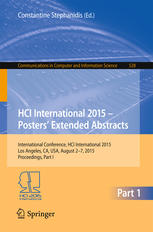

Most ebook files are in PDF format, so you can easily read them using various software such as Foxit Reader or directly on the Google Chrome browser.
Some ebook files are released by publishers in other formats such as .awz, .mobi, .epub, .fb2, etc. You may need to install specific software to read these formats on mobile/PC, such as Calibre.
Please read the tutorial at this link: https://ebookbell.com/faq
We offer FREE conversion to the popular formats you request; however, this may take some time. Therefore, right after payment, please email us, and we will try to provide the service as quickly as possible.
For some exceptional file formats or broken links (if any), please refrain from opening any disputes. Instead, email us first, and we will try to assist within a maximum of 6 hours.
EbookBell Team

5.0
98 reviewsThis is the first volume of the two-volume set (CCIS 528 and CCIS 529) that contains extended abstracts of the posters presented during the 17th International Conference on Human-Computer Interaction, HCII 2015, held in Heraklion, Crete, Greece in August 2015.
The total of 1462 papers and 246 posters presented at the HCII 2015 conferences was carefully reviewed and selected from 4843 submissions. These papers address the latest research and development efforts and highlight the human aspects of design and use of computing systems. The papers thoroughly cover the entire field of human-computer interaction, addressing major advances in knowledge and effective use of computers in a variety of application areas.
The papers included in this volume are organized in the following topical sections: design and evaluation methods, techniques and tools; cognitive and psychological issues in HCI; virtual, augmented and mixed reality; cross-cultural design; design for aging; children in HCI; product design; gesture, gaze and motion detection, modelling and recognition; reasoning, optimisation and machine learning for HCI; information processing and extraction for HCI; image and video processing for HCI; brain and physiological parameters monitoring; dialogue systems.